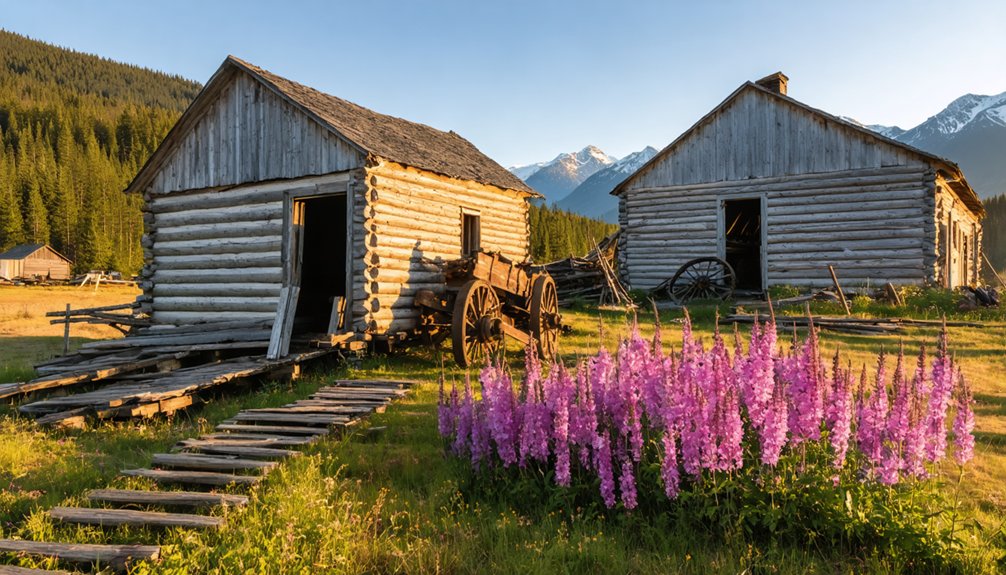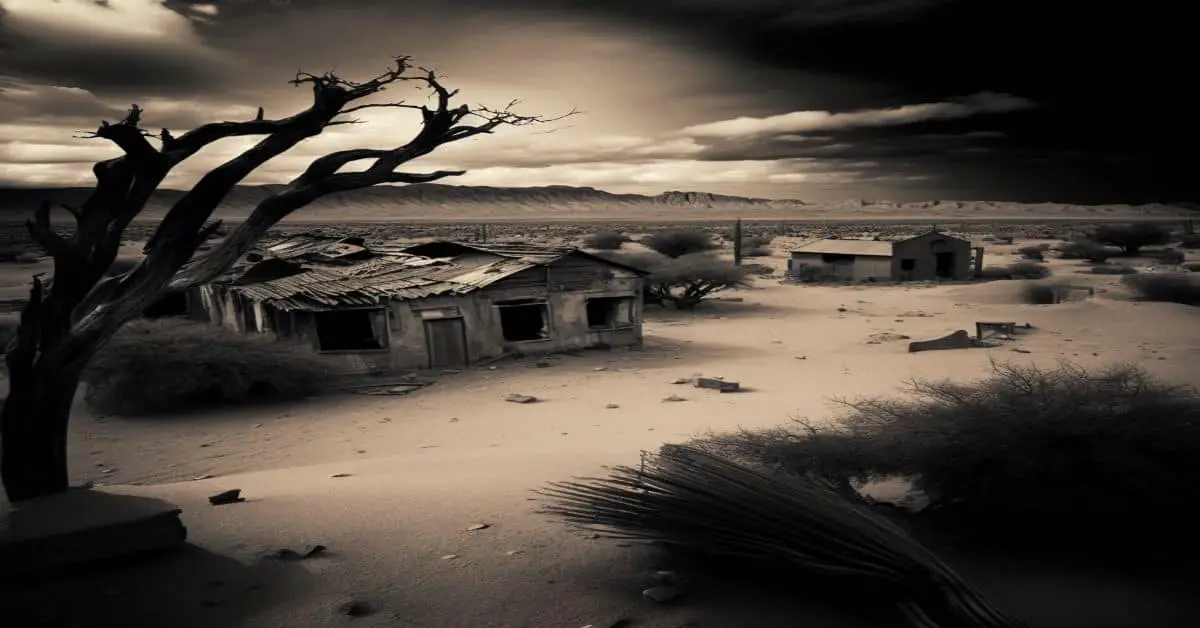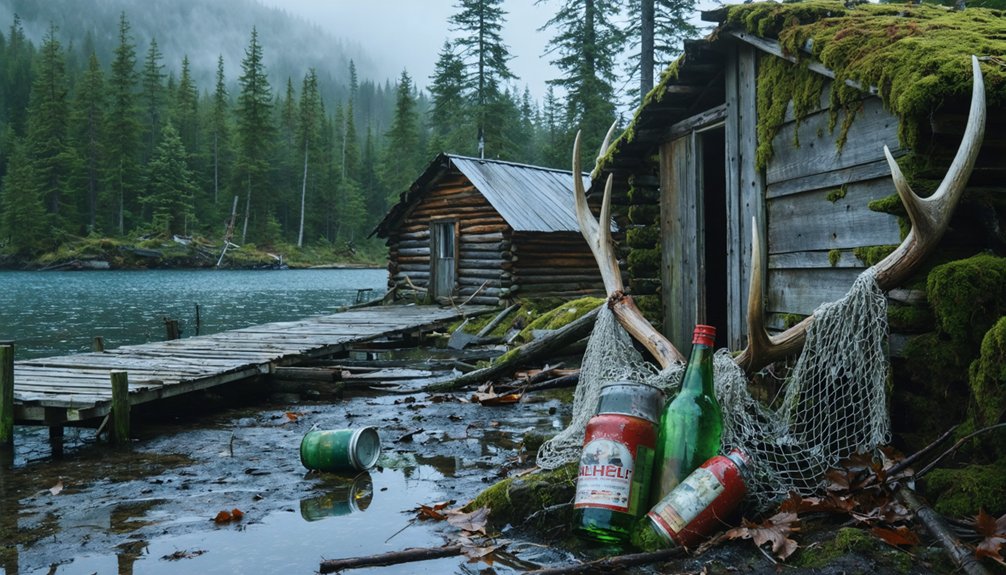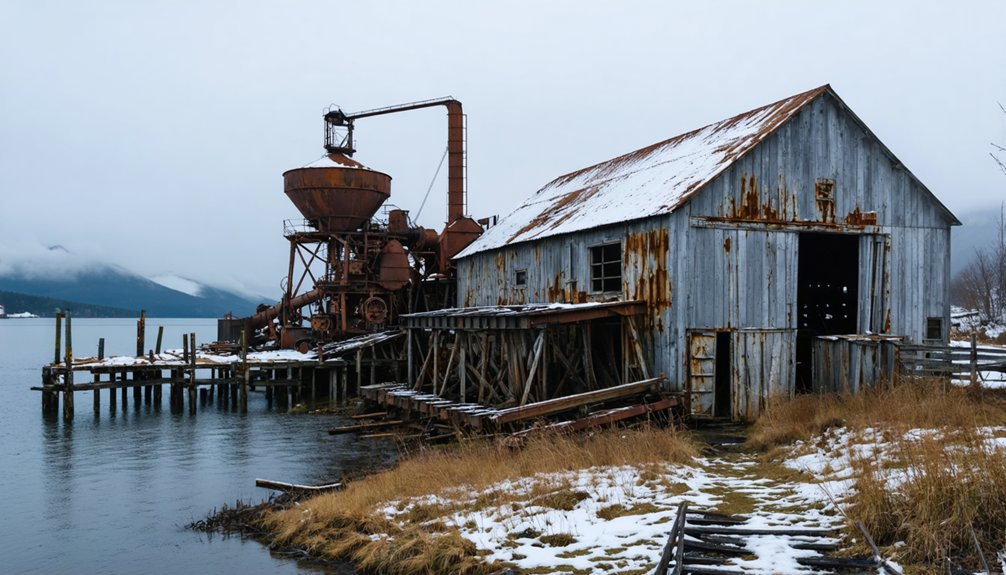You’ll find Chisana in Alaska’s Wrangell-St. Elias National Park, site of the state’s last major gold rush in 1913. After gold’s discovery by prospectors including Nels Nelson and Billy James, this remote wilderness transformed into the world’s largest log cabin settlement, hosting over 1,000 miners across 450 cabins. Though mining declined by the 1930s, Chisana’s preserved log structures and rich cultural heritage offer a genuine window into Alaska’s rugged mining past.
Key Takeaways
- Chisana became Alaska’s largest log cabin settlement during the 1913 gold rush, with over 1,000 miners building approximately 450 cabins.
- The remote ghost town is accessible only by bush plane and features preserved log cabins listed on the National Register of Historic Places.
- Gold production peaked in 1914 with 325 men working 21 claims, but declined through the 1930s due to depleted deposits.
- Visitors can explore the historic mining landscape, which includes original log cabins scattered across the wilderness near Gold Hill.
- The town’s isolation provides pristine photography opportunities of historic structures, mountain vistas, and wildlife in untouched Alaskan wilderness.
The Birth of Alaska’s Largest Log Cabin Town
While gold rushes were common in Alaska’s history, Chisana’s discovery in 1913 sparked the territory’s last major stampede, giving birth to what became known as the world’s largest log cabin settlement. Nestled between the Nutzotin and Wrangell Mountains, this remote frontier town quickly grew to house over 1,000 miners and their families.
You’ll find that Chisana’s architecture reflected the resourcefulness of its builders, who constructed roughly 450 log cabins using local timber. The town’s layout followed typical gold rush patterns, but stood out for its impressive two-story log building – a rare sight in such remote locations. Today, the area is only accessible by bush planes or snowmobiles. The National Park Service has preserved the area’s rich history through the restoration of four log buildings, ensuring these historical structures remain for future generations to explore.
The settlers used peg and notch construction techniques to create not just homes, but also businesses and community structures, establishing a self-sufficient outpost in Alaska’s rugged wilderness.
Gold Rush Fever: From Discovery to Boom
After decades of Alaskan gold rushes, Chisana’s 1913 discovery sparked the territory’s final major stampede when prospectors Nels Nelson, Billy James, Matilda Wales, Fred Best, and native guide Shushanna Joe struck gold in the remote Wrangell Mountains.
In 1913, five intrepid prospectors discovered gold in Alaska’s Wrangell Mountains, launching the territory’s last major rush to riches.
You’ll find that thousands of experienced miners, many veterans of the Klondike, raced to this isolated valley despite its harsh terrain and limited accessibility.
As gold mining operations expanded, Chisana quickly transformed into what became known as “the largest log cabin town in the world.” The rush arrived at a pivotal moment when older Yukon camps were declining and large industrial operations were taking over. The discovery of gold at Chisana happened the same year as the Marshall gold strike, marking a significant year in Alaska’s mining history.
Like the tragic Chilkoot Pass avalanche of 1898 that claimed 65 lives, the harsh conditions of the Wrangell Mountains posed significant risks to prospectors.
Today, the site’s extreme remoteness has aided in historic preservation, leaving behind intact mining equipment and structural remains that tell the story of Alaska’s last great gold rush.
Life in the Remote Wilderness
The raw wilderness surrounding Chisana presents unique challenges that shaped daily life during the gold rush and continue to test modern visitors.
You’ll find yourself completely isolated in the heart of Wrangell-St. Elias National Park, where access is limited to bush flights over dramatic mountain ranges and glaciers. Basic survival skills become essential as you face extreme weather conditions and manage limited resources.
Living off-grid isn’t optional here – it’s a necessity. You’ll need to master solar power systems, wood stoves, and wildlife management. The region experiences just four hours of daylight during the winter months, making resource management critical.
The harsh environment demands community resilience, with residents supporting each other despite vast distances between settlements. While the isolation can test your mental fortitude, you’ll discover an unparalleled connection to Alaska’s untamed landscape, where the remnants of gold rush history blend with the raw beauty of the wilderness. The ghost town’s abandoned mining buildings stand as silent witnesses to its once-bustling past during the early 1900s.
Indigenous Peoples and Early Settlement
The Upper Tanana Dineh, an Athabascan people, inhabited the Chisana River Basin since time immemorial, establishing extensive networks of seasonal camps throughout the region.
You’ll find evidence of their traditional territory stretching across what’s now the Alaska-Canada border, where they maintained sophisticated trading relationships with neighboring indigenous groups.
Their land use patterns centered on the river systems, where they’d move between established camps for hunting, fishing, and gathering according to seasonal cycles.
Original Athabascan Groups’ Territory
Prior to becoming a ghost town, Chisana’s territory belonged to three major Athabascan groups who shared the region: the Ahtna, Southern Tutchone, and Upper Tanana peoples.
The Athabascan territories were distinctly defined, with Ahtna lands extending east from Batzulnetas to the Nabesna River, while Southern Tutchone territory covered the White River’s lower and middle reaches. The Upper Tanana controlled the Chisana River area, establishing the region’s first known settlement on Cross Creek. The first documented village was established by Tanana people six miles from Chisana.
These indigenous peoples, who called themselves Dene, maintained cultural continuity through matrilineal social structures and semi-nomadic lifestyles. The Upper Nabesna-Upper Chisana band maintained traditional hunting territories in the area until Euro-American contact disrupted their way of life.
They lived in small familial bands of 20-40 people, moving seasonally to hunt moose, caribou, and Dall sheep. Their villages were strategically positioned near river tributaries, supporting traditional hunting and gathering practices adapted to the mountainous terrain.
Cross-Cultural Trading Networks
While the Athabascan peoples maintained distinct territories, they developed sophisticated trading networks that connected various indigenous groups across the region.
These trade dynamics were particularly evident in the relationships between the Upper Tanana people and their neighbors, including the Ahtna and Tutchone. You’ll find that before European contact, these networks weren’t just about commerce – they facilitated essential cultural exchanges and knowledge sharing. Similar to the extensive trade networks that existed throughout the Western Hemisphere before 1491, these connections supported thriving market economies.
Women trade leaders played vital roles in managing resources and building wealth through commerce between communities.
- Coastal-inland trade routes transported valuable resources like oolichan fish
- Item-for-item bartering dominated transactions before the cash economy
- Waterways served as crucial transportation corridors for goods
- Regional cooperation strengthened bonds between different language groups
The Chisana River basin became a hub where families from different cultural backgrounds settled and traded, demonstrating the adaptability of indigenous peoples in maintaining their heritage while embracing new economic opportunities.
Traditional Land Use Patterns
Long before the gold rush transformed Chisana, indigenous Upper Tanana Dineh families established intricate seasonal settlement patterns throughout the river basin.
You’ll find evidence of their traditional ecological knowledge in over 600 place names they used, each connecting physical landmarks to cultural identity and subsistence activities.
Their seasonal resource management reflected deep understanding of the land. They’d hunt moose and caribou across vast territories, fish using wheels and nets near settlements, and gather plants in specific locations based on traditional knowledge.
The Upper Tanana people maintained semi-permanent camps strategically positioned for ideal resource access.
Mining Operations and Economic Development
After gold’s discovery in 1913 by Nels Nelson’s group, Chisana rapidly evolved into Alaska’s last major gold rush settlement, earning the nickname “the largest log cabin town in the world.”
Chisana’s explosive growth after Nelson’s 1913 gold discovery transformed it into Alaska’s final great gold rush boomtown.
The initial mining operations concentrated within a 5-mile diameter around Gold Hill, focusing primarily on Bonanza Creek and its tributaries.
You’ll find the economic impacts were significant but short-lived, with mining techniques adapting to challenging local conditions:
- Placer mining dominated early operations, using simple tools and sluice boxes
- Hydraulic mining became prevalent for accessing bench deposits, despite water scarcity
- Peak activity employed 325 men across 21 claims during summer 1914
- Operations scaled down to smaller endeavors including hand mining and dredging
The district’s development spurred local transportation networks, though harsh conditions and isolation ultimately limited long-term mining potential.
Daily Challenges in the Last Frontier
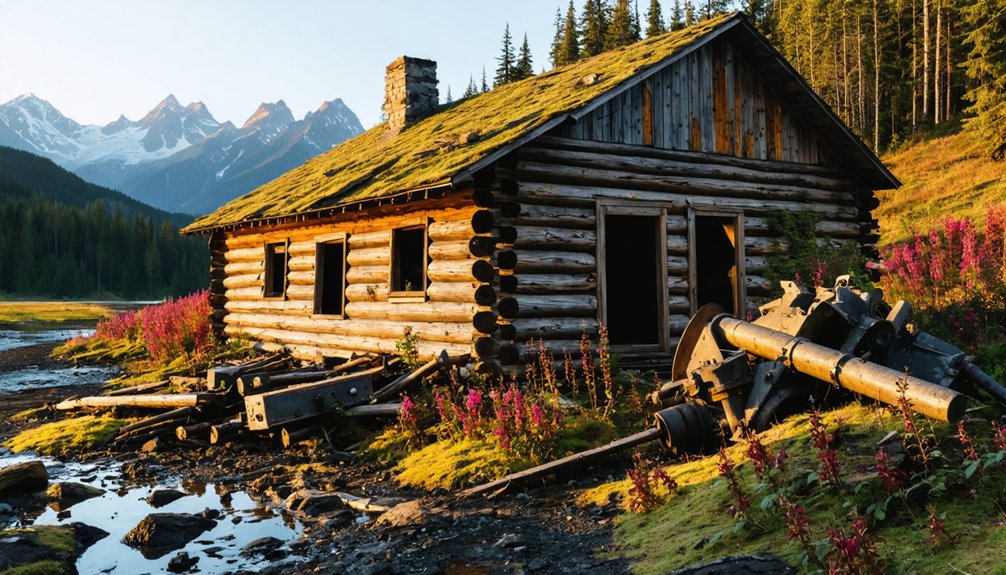
Today’s residents of Chisana face challenges that the early gold miners couldn’t have imagined. Daily survival requires mastering off grid living in extreme isolation, where you’ll rely on twice-weekly mail planes for supplies and basic necessities.
You’ll need to adapt to life without modern conveniences – collecting water manually, using outhouses, and conserving limited resources from solar panels and generators.
Your daily routine revolves around essential tasks like gathering firewood, maintaining heat through wood stoves, and managing limited water supplies.
During the harsh winter months, you’ll contend with minimal daylight and challenging weather conditions that affect everything from transportation to mental health.
The remote location means you must be self-sufficient, as emergency services and medical care are severely restricted by the terrain and seasonal conditions.
Transportation and Supply Routes
When early prospectors and miners ventured into Chisana’s remote wilderness, they relied on a network of rugged trails pioneered by Native guides and explorers.
Supply logistics involved hauling equipment and provisions via horseback, sleds, and human portage along treacherous routes that followed river drainages and mountain passes.
Transportation challenges were especially intimidating due to:
Moving supplies through Chisana’s wilderness presented daunting obstacles that tested even the most seasoned prospectors and transport crews.
- Harsh winters and deep snow that limited access to seasonal windows
- Spring thaws causing washouts and impassable mud conditions
- Dense forests and mountainous terrain requiring constant trail maintenance
- Limited infrastructure, making heavy equipment transport costly and time-consuming
The completion of the Copper River and Northwestern Railway and improvements to the Valdez Trail eventually eased some burdens, but Chisana’s remote location meant it remained largely dependent on primitive supply routes throughout its mining heyday.
The Decline of a Mining Empire
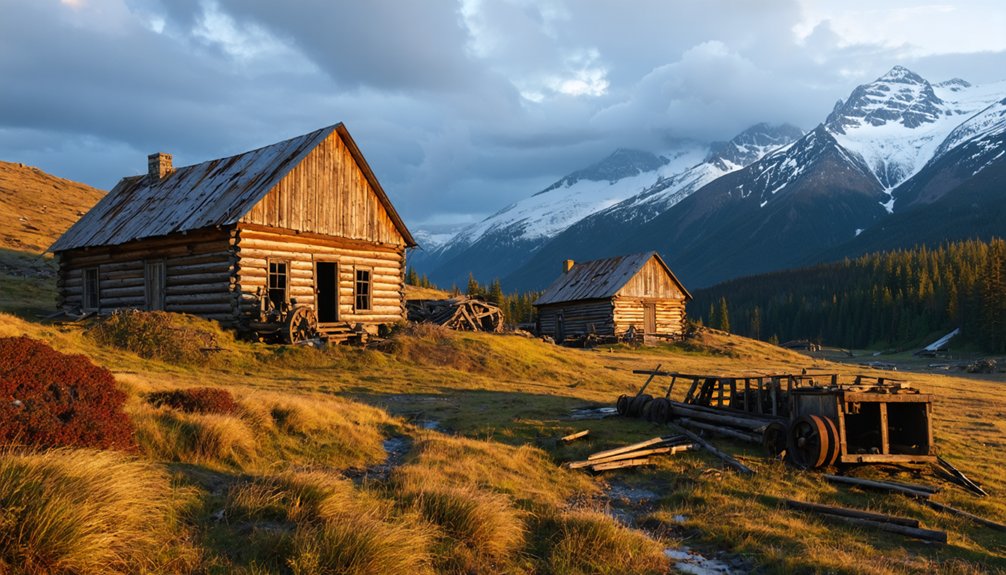
You’ll find Chisana’s decline followed a predictable pattern, as gold production peaked in 1914 with 325 miners but steadily decreased through the 1930s due to depleted placer deposits and fixed gold prices.
The remote location and harsh environmental conditions made large-scale mining operations impractical, while World War II’s restrictions on gold mining dealt another significant blow to the region’s productivity.
Boom to Bust Timeline
The dramatic rise and fall of Chisana’s mining empire traces back to 1891, when initial explorations yielded copper but no gold, dampening early interest in the region.
You’ll find that Chisana’s cultural heritage truly emerged in 1913, when a major gold discovery sparked Alaska’s last significant gold rush.
Mining technology remained basic, with hydraulic methods dominating the small-scale operations.
The timeline from boom to bust unfolded rapidly:
- 1913-1915: Peak mining activity with rapid settlement growth and infrastructure development
- 1920s: Production plateaued as accessible deposits depleted
- 1930s: Great Depression struck, severely limiting investment and operations
- 1942: World War II effectively ended commercial mining, transforming Chisana into the well-preserved ghost town you can explore today.
Gold Production Slows Down
Despite initial success during the gold rush years, Chisana’s mining operations faced mounting challenges by the late 1910s that signaled the beginning of their decline. The global depression and falling gold prices severely impacted economic sustainability, while rising operational costs made mining profitability increasingly difficult to maintain.
You’ll find that Chisana’s production numbers tell the stark story – from 1913 to 1959, the district yielded only 44,760 ounces from placers, with output becoming negligible after World War II.
By 1924, just eight mines remained active, producing a mere $23,400 in gold. The district’s remote location, limited water resources, and small deposit sizes prevented large-scale operations from taking root.
The lack of developed infrastructure and modern equipment meant most operations remained seasonal and small-scale, unable to compete with industrial mining elsewhere in Alaska.
Population Exodus Patterns
With gold production dwindling and operational costs rising, Chisana’s population began its steep decline in the late 1910s.
You’ll find that the population migration followed a predictable pattern as miners sought economic sustainability elsewhere, particularly in established mining centers like Fairbanks.
- The closure of the local recording office in 1930 signaled the end of official oversight
- Loss of railway access in 1938 isolated the remaining residents
- World War I’s aftermath created unfavorable economic conditions
- Small-scale operations couldn’t sustain the community’s needs
The exodus wasn’t just about individual miners – it represented the collapse of an entire community structure.
When the Copper River and Northwestern Railway shut down, it effectively cut off Chisana’s lifeline to the outside world.
Those who stayed faced increasingly difficult conditions, leading to the area’s eventual transformation into the ghost town you’d see today.
Preserving Chisana’s Historical Legacy
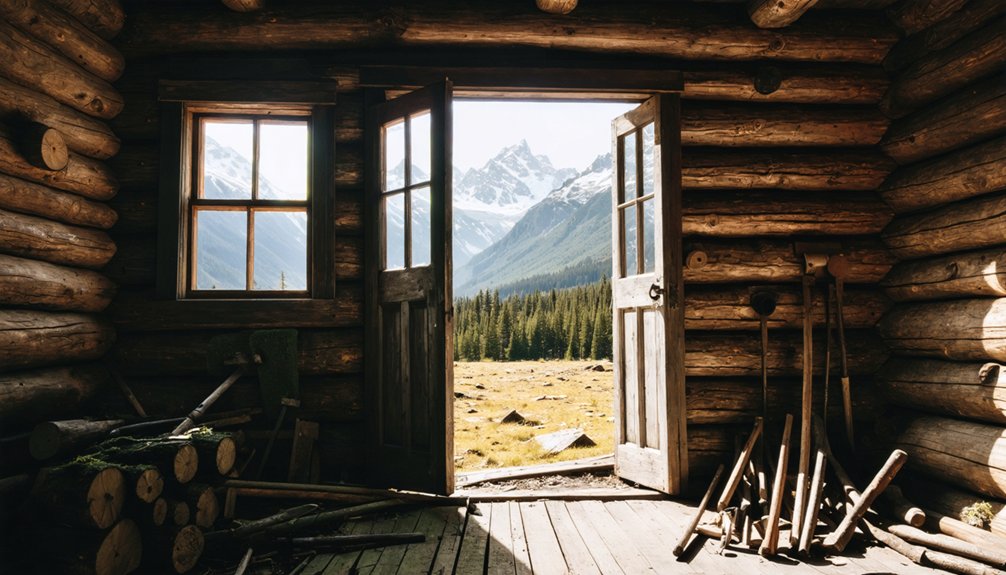
The National Park Service oversees preservation techniques to protect remnants of hydraulic works, water systems, and mining camps.
Community involvement helps raise awareness, though the site’s remote location in the Nutzotin Mountains makes restoration work difficult.
The district’s preservation captures both technological and social aspects of the gold rush era, including the multicultural heritage of early prospectors like Nels Nelson and Shushanna Joe, while carefully managing visitor access to protect these fragile historical remains.
Modern Day Ghost Town Experience
When you visit Chisana today, you’ll find preserved log cabins scattered across the remote landscape, offering a genuine glimpse into Alaska’s mining history.
Your journey requires careful planning, as access is limited to bush planes or specialized vehicles that can navigate the rugged terrain within Wrangell-St. Elias National Park.
The site’s isolation creates ideal conditions for wilderness photography, allowing you to capture both the historic structures and the untamed natural surroundings that have reclaimed much of this ghost town.
Preserved Historical Log Cabins
Nestled between the Nutzotin and Wrangell Mountains, Chisana’s preserved log cabins stand as silent witnesses to Alaska’s gold rush heritage.
Once known as “the largest log cabin town in the world,” these historic structures face ongoing environmental challenges from harsh weather and permafrost.
The National Park Service has undertaken critical log cabin restoration efforts, particularly on the Too Much Johnson Cabin, to protect these irreplaceable pieces of history.
- Original curved log cabin architecture showcases pioneer craftsmanship
- Historic District designation protects the cultural landscape
- Natural elements constantly threaten structural integrity
- Preservation efforts battle time and weather to maintain authenticity
Listed on the National Register of Historic Places as the Chisana Historic Mining Landscape, these cabins offer you a rare glimpse into the rugged lives of gold rush prospectors who sought their fortunes in this remote valley.
Remote Access Adventures
Deep within Wrangell-St. Elias National Park lies Chisana, where geographic isolation defines your adventure.
You’ll need to charter a bush plane from Tok or McCarthy, as no roads reach this remote ghost town. The unstaffed airstrip serves as your gateway to raw wilderness exploration.
Your journey demands complete self-sufficiency. You’ll pack all necessities – food, water, shelter, and emergency supplies – as no amenities exist on-site.
Without cell service or nearby medical facilities, your survival skills become essential. Summer months offer the only reliable access window, though weather can quickly ground flights and extend your stay.
The reward? You’ll experience untouched ruins and mining relics in profound solitude, where nature’s soundscape and historical echoes create an authentic frontier experience few modern travelers ever encounter.
Wilderness Photography Opportunities
Three distinct photographic opportunities await at Chisana’s ghost town site: the weathered log cabins and mining remnants, the dramatic mountain vistas of Wrangell-St. Elias, and the abundant wildlife that roams freely through this remote wilderness.
You’ll want to bring wide-angle lenses for capturing the town’s historical structures against mountain backdrops, while HDR techniques help balance the harsh lighting conditions you’ll encounter.
- Dawn and dusk provide ideal natural lighting for wilderness photography
- Remote location offers unobstructed views for panoramic shots
- Abandoned structures create compelling subjects for documentary-style images
- Wildlife encounters present unique opportunities for capturing candid nature shots
Plan your visit carefully, as weather conditions can change rapidly.
Consider using drone photography to document the town’s layout while respecting preservation guidelines and environmental regulations.
Frequently Asked Questions
What Wildlife Encounters Were Common During Chisana’s Gold Rush Period?
Though you’d expect isolation, you’d regularly face wildlife sightings with brown bears, black bears, and moose near camp. Animal interactions included wolves in remote areas and mountain goats at higher elevations.
Did Any Famous Outlaws or Criminals Operate in Chisana?
You won’t find any famous outlaws in Chisana’s legends or outlaw history. Unlike other Alaskan gold rush towns, its remote location and harsh conditions kept notorious criminals from establishing operations there.
What Happened to the Gold Claims After the Town Was Abandoned?
Like scattered gold flecks in a pan, you’ll find that gold claim ownership persisted after abandonment, with some miners maintaining their stakes, while others sold rights or left mining equipment behind.
Were There Any Notable Marriages or Births in Chisana?
You won’t find records of notable weddings or historical births in the town’s brief existence. While marriage records exist from 1913-1917, they show only routine unions among miners and settlers.
Did Any Prospectors Become Millionaires From Chisana’s Gold Rush?
Fortune’s flame burned dim at Chisana – you won’t find any millionaire success stories here. The total gold rush value of $250,000 meant prospector fortunes stayed modest, unlike other Alaskan gold rush legends.
References
- https://www.nps.gov/wrst/learn/historyculture/chisana-history.htm
- https://www.nps.gov/parkhistory/online_books/alaska/chisana.pdf
- http://north2arctic.com/chisana/
- https://npshistory.com/publications/wrst/bleakley/chap1.htm
- https://en.wikipedia.org/wiki/List_of_ghost_towns_in_Alaska
- https://npshistory.com/publications/wrst/bleakley/chap2.htm
- https://www.miningnewsnorth.com/story/2023/02/03/mining-history/rediscovering-the-gold-rush-town-of-chena/7802.html
- https://www.nps.gov/places/chisana.htm
- https://www.shortfield.com/listing/chisana-ak/
- https://sah-archipedia.org/essays/AK-01-0001-0004-0008
